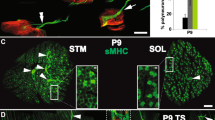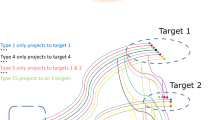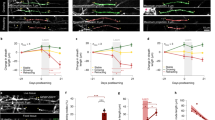Abstract
A large body of evidence shows that molecular cues promote specific synapse formation by guiding axons and by mediating their association with targets, but much less is known about the contribution of physical cues (such as mechanical constraints) to these processes. Here we used the peripheral motor system to investigate the latter issue. In living mice, we viewed individual motor axons bearing a fluorescent reporter, and mapped the cohort of muscle fibers that they innervated both before and after nerve damage. When gross trauma was minimized (by a nerve-crushing rather than nerve-cutting procedure), regenerating axons retraced their former pathways, bifurcated at original branch points, and formed neuromuscular junctions on the same fibers that they originally innervated. Axonal growth through tubes of non-neural cells seemed to account for this specificity, and specificity degraded when the tubes were cut. These results suggest that nonspecific guidance cues can be sufficient to generate specific synaptic circuitry.
This is a preview of subscription content, access via your institution
Access options
Subscribe to this journal
Receive 12 print issues and online access
$209.00 per year
only $17.42 per issue
Buy this article
- Purchase on Springer Link
- Instant access to full article PDF
Prices may be subject to local taxes which are calculated during checkout






Similar content being viewed by others
References
Bernstein, J.J. & Guth, L. Nonselectivity in establishment of neuromuscular connections following nerve regeneration in the rat. Exp. Neurol. 4, 262–275 (1961).
Brushart, T.M. & Mesulam, M.M. Alteration in connections between muscle and anterior horn motoneurons after peripheral nerve repair. Science 9, 603–605 (1980).
Langley, J.N. On the regeneration of pre-ganglionic and post-ganglionic visceral nerve fibers. J. Physiol. (Lond.) 22, 215–230 (1897).
Diamond, J., Foerster, A., Holmes, M. & Coughlin, M. Sensory nerves in adult rats regenerate and restore sensory function to the skin independently of endogenous NGF. J. Neurosci. 12, 1467–1476 (1992).
Nja, A. & Purves, D. Re-innervation of guinea-pig superior cervical ganglion cells by preganglionic fibres arising from different levels of the spinal cord. J. Physiol. 272, 633–651 (1977).
Desantis, M. & Norman, W.P. Location and completeness of reinnervation by two types of neurons at a single target: the feline muscle spindle. J. Comp. Neurol. 336, 66–76 (1993).
Hendry, I.A., Hill, C.E. & Watters, D.J. Long term retention of Fast Blue in sympathetic neurons after axotomy and regeneration-demonstration of incorrect reconnections. Brain Res. 376, 292–298 (1986).
Stankovic, N., Johansson, O. & Hildebrand, C. Occurrence of epidermal nerve endings in glabrous and hairy skin of the rat foot after sciatic nerve regeneration. Cell Tissue Res. 284, 161–166 (1996).
Brushart, T.M., Henry, E.W. & Mesulam, M.M. Reorganization of muscle afferent projections accompanies peripheral nerve regeneration. Neuroscience 6, 2053–2061 (1981).
Carlstedt, T. Approaches permitting and enhancing motor neuron regeneration after spinal cord, ventral root, plexus and peripheral nerve injuries. Curr. Opin. Neurobiol. 13, 683–686 (2000).
Wigston, D.J. Selective innervation of transplanted limb muscles by regenerating motor axons in the axolotl. J. Neurosci. 6, 2757–2763 (1986).
Wigston, D.J. & Sanes, J.R. Selective reinnervation of adult mammalian muscle by axons from different segmental levels. Nature 299, 464–467 (1982).
Wigston, D.J. & Sanes, J.R. Selective reinnervation of rat intercostal muscles transplanted from different segmental levels to a common site. J. Neurosci. 5, 1208–1221 (1985).
Hardman, V.J. & Brown, M.C. Accuracy of reinnervation of rat internal intercostal muscles by their own segmental nerves. J. Neurosci. 7, 1031–1036 (1987).
Laskowski, M.B. & Sanes, J.R. Topographically selective reinnervation of adult mammalian skeletal muscles. J. Neurosci. 8, 3094–3099 (1988).
DeSantis, M., Berger, P.K., Laskowski, M.B. & Norton, A.S. Regeneration by skeletomotor axons in neonatal rats is topographically selective at an early stage of reinnervation. Exp. Neurol. 116, 229–239 (1992).
Laskowski, M.B., Colman, H., Nelson C. & Lichtman, J.W. Synaptic competition during the reformation of a neuromuscular map. J. Neurosci. 18, 7328–7335 (1998).
Feng, G. et al. Imaging neuronal subsets in transgenic mice expressing multiple spectral variants of GFP. Neuron 28, 41–51 (2000).
Chalfie, M., Tu, Y., Euskirchen, G., Ward, W.W. & Prasher, D.C. Green fluorescent protein as a marker for gene expression. Science 263, 802–805 (1994).
Keller-Peck, C.R. et al. Asynchronous synapse elimination in neonatal motor units: studies using GFP transgenic mice. Neuron 31, 381–394 (2001).
Rich, M.M. & Lichtman, J.W. In vivo visualization of pre- and postsynaptic changes during synapse elimination in reinnervated mouse muscle. J. Neurosci. 9, 1781–1805 (1989).
Balice-Gordon, R.J. & Lichtman, J.W. In vivo observations of pre- and postsynaptic changes during the transition from multiple to single innervation at developing neuromuscular junctions. J. Neurosci. 13, 834–855 (1993).
Ramon y Cajal, S. Degeneration and Regeneration of the Nervous System Vol. 1 (eds. DeFelipe, J. & Jones, E. G.) 66–304 (Oxford Univ. Press, New York, 1928, reprinted 1991).
Gutmann, E. & Young, J.Z. The re-innervation of muscle after various periods of atrophy. J. Anatomy 78, 15–43 (1944).
Scherer, S.S. & Easter, S.S. Jr. Degenerative and regenerative changes in the trochlear nerve of goldfish. J. Neurocytol. 13, 519–565 (1984).
Brown, M.C. & Hardman, V.J. A reassessment of the accuracy of reinnervation by motor neurons following crushing or freezing of the sciatic or lumbar spinal nerves of rats. Brain 110, 695–705 (1987).
Sanes, J.R., Marshall, L.M. & McMahan, U.J. Reinnervation of muscle fiber basal lamina after removal of myofibers. Differentiation of regenerating axons at original synaptic sites. J. Cell Biol. 78, 176–198 (1978).
Thomas, P.K., Berthold, C-H. & Ochoa, J. in Peripheral Neuropathy 3rd Edn., Vol. 1 (eds. Dyck, P. J. & Thomas, P. K.) 28–73 (W. B. Saunders, Philadelphia, 1993).
Young, J.Z. The functional repair of nervous tissue. Physiol. Rev. 22, 318–374 (1942).
Griffin, J.W. & Hoffman, P.N. in Peripheral Neuropathy 3rd Edn., Vol. 1 (eds. Dyck, P. J. & Thomas, P. K.) 361–367 (W. B. Saunders, Philadelphia, 1993).
Balice-Gordon, R.J. & Lichtman, J.W. In vivo visualization of the growth of pre-and postsynaptic elements of neuromuscular junctions in the mouse. J. Neurosci. 10, 894–908 (1990).
Bastmeyer, M., Daston, M.M., Possel, H. & O'Leary, D.D. Collateral branch formation related to cellular structures in the axon tract during corticopontine target recognition. J. Comp. Neurol. 392, 1–18 (1998).
Melancon, E., Liu, D.W., Westerfield, M. & Eisen, J.S. Pathfinding by identified zebrafish motoneurons in the absence of muscle pioneers. J. Neurosci. 17, 7796–7804 (1997).
Brown, M.C., Holland, R.L. & Hopkins, W.G. Motor nerve sprouting. Ann. Rev. Neurosci. 4, 17–42 (1981).
Kugelberg, E., Edstrom, L. & Abbruzzese, M. Mapping of motor units in experimentally reinnervated rat muscle. Interpretation of histochemical and atrophic fiber patterns in neurogenic lesions. J. Neurol. Neurosurg. Psychiatry 33, 319–329 (1970).
Sunderland, S. Nerves and Nerve Injuries Part 2, 69–144 (Churchill Livingstone, London, 1978).
Mueller, B.K. Growth cone guidance: first steps towards a deeper understanding. Annu. Rev. Neurosci. 22, 351–388 (1999).
Benson, D.L., Colman, D.R. & Huntley, G.W. Molecules, maps and synapse specificity. Nat. Rev. Neurosci. 2, 899–909 (2001).
Feng, G. et al. Roles for ephrins in positionally selective synaptogenesis between motor neurons and muscle fibers. Neuron 25, 295–306 (2000).
Weiss, P. In vitro experiments on the factors determining the course of the outgrowing nerve fiber. J. Exp. Zool. 68, 393–448 (1934).
Ide, C. Peripheral nerve regeneration. Neurosci. Res. 25, 101–121 (1996).
Fu, S.Y. & Gordon, T. The cellular and molecular basis of peripheral nerve regeneration. Mol. Neurobiol. 14, 67–116 (1997).
Wang, K.H. et al. Biochemical purification of a mammalian slit protein as a positive regulator of sensory axon elongation and branching. Cell 96, 771–784 (1999).
Keller-Peck, C.R. et al. Glial cell line-derived neurotrophic factor administration in postnatal life results in motor unit enlargement and continuous synaptic remodeling at the neuromuscular junction. J. Neurosci. 21, 6136–6146 (2001).
Westerfield, M. Substrate interactions affecting motor growth cone guidance during development and regeneration. J. Exp. Biol. 132, 161–175 (1987).
Kiefer, R., Kieseier, B.C., Stoll, G. & Hartung, H.P. The role of macrophages in immune-mediated damage to the peripheral nervous system. Prog. Neurobiol. 64, 109–127 (2001).
Salonen, V., Aho, H., Röyttä, M. & Peltonen, J. Quantitation of Schwann cells and endoneurial fibroblast-like cells after experimental nerve trauma. Acta Neuropathol. (Berl.) 75, 331–336 (1988).
Lingle, C.J. & Steinbach, J.H. Neuromuscular blocking agents. Int. Anesthesiol. Clin. 26, 288–301 (1988).
Akaaboune, M., Culican, S.M., Turney, S.G. & Lichtman, J.W. Rapid and reversible effects of activity on acetylcholine receptor density at the neuromuscular junction in vivo. Science 15, 503–507 (1999).
Acknowledgements
We thank M. Bernstein and G. Feng for participating in initial experiments, and J. Tollett for assistance. This research was supported by grants from the National Institutes of Health (to J.W.L. and J.R.S.) and from the Bakewell NeuroImaging Fund.
Author information
Authors and Affiliations
Corresponding authors
Ethics declarations
Competing interests
The authors declare no competing financial interests.
Rights and permissions
About this article
Cite this article
Nguyen, Q., Sanes, J. & Lichtman, J. Pre-existing pathways promote precise projection patterns. Nat Neurosci 5, 861–867 (2002). https://doi.org/10.1038/nn905
Received:
Accepted:
Published:
Issue Date:
DOI: https://doi.org/10.1038/nn905
This article is cited by
-
The structural and functional corneal reinnervation mechanism at different regions after LASIK—an in vivo confocal microscopy study
Graefe's Archive for Clinical and Experimental Ophthalmology (2022)
-
Lessons from Injury: How Nerve Injury Studies Reveal Basic Biological Mechanisms and Therapeutic Opportunities for Peripheral Nerve Diseases
Neurotherapeutics (2021)
-
Mechanisms of Schwann cell plasticity involved in peripheral nerve repair after injury
Cellular and Molecular Life Sciences (2020)
-
Assessment of axonal sprouting and motor performance after hypoglossal–facial end-to-side nerve repair: experimental study in rats
Experimental Brain Research (2020)
-
CXCL1 and CXCL2 Inhibit the Axon Outgrowth in a Time- and Cell-Type-Dependent Manner in Adult Rat Dorsal Root Ganglia Neurons
Neurochemical Research (2019)



